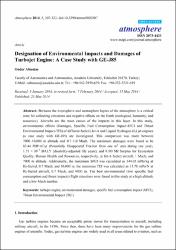Designation of Environmental Impacts and Damages of Turbojet Engine: A Case Study with GE-J85
Özet
Between the troposphere and stratosphere layers of the atmosphere is a critical zone for collecting emissions and negative effects on the Earth (ecological, humanity, and resources). Aircrafts are the main causes of the impacts in this layer. In this study, environmental effects (Damages, Specific Fuel Consumption Impact-SFCI and Thrust Environmental Impact-TEI) of different fueled (Jet-A and Liquid Hydrogen-H-2) jet engines (a case study with GE-J85) are investigated. This comparison was made between 7000-10,000 m altitude and 0.7-1.0 Mach. The maximum damages were found to be 82.44 PDF.m(2).yr (Potentially Disappeared Fraction from one m(2) area during one year), 1.75 x 10(-3) DALY (disability-adjusted life years), and 8100 MJ Surplus for Ecosystem Quality, Human Health and Resources, respectively, at Jet-A fueled aircraft, 1 Mach, and 7000 m altitude. Additionally, the maximum SFCI was calculated as 344.03 mPts/kg at H-2-fueled, 0.7 Mach, and 10,000 m; the minimum TEI was calculated as 13.78 mPts/N at H-2-fueled aircraft, 0.7 Mach, and 9000 m. The best environmental (low specific fuel consumption and thrust impacts) flight situations were found in this study at a high altitude and a low Mach number.


















